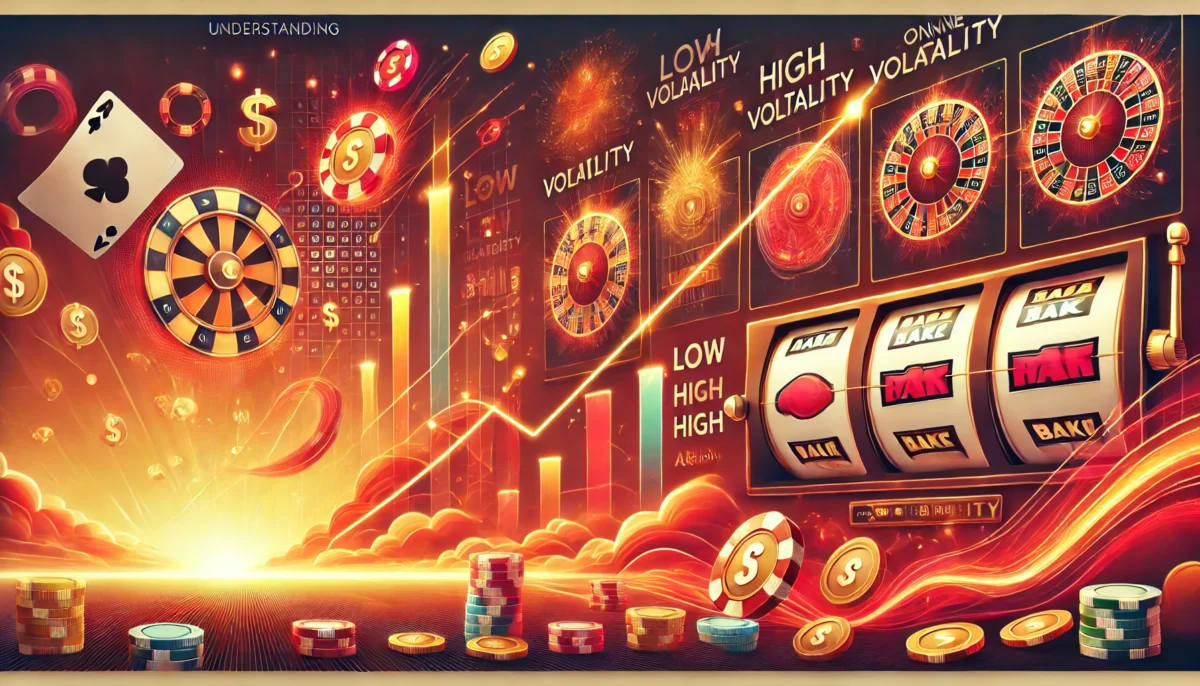When it comes to online slots, volatility is one of the most critical factors to understand. It determines the balance between the size of payouts and how frequently they occur, directly affecting your gameplay experience. Whether you’re aiming for big jackpots or consistent small wins, understanding slot volatility can help you choose games that match your playing style and goals.
Here’s everything you need to know about volatility and how it impacts your wins.
1. What Is Slot Volatility?
Slot volatility, also known as variance, measures the risk level of a game and its payout patterns. It answers two essential questions:
- How often does the slot pay out?
- How big are the payouts?
Volatility is typically divided into three categories:
- Low Volatility: Frequent but smaller payouts.
- Medium Volatility: A balance between payout size and frequency.
- High Volatility: Infrequent payouts, but they’re larger when they occur.
2. How Volatility Affects Your Gameplay
The volatility of a slot determines how the game feels and plays:
Low Volatility Slots
- Frequency of Wins: High, with frequent payouts.
- Payout Size: Smaller amounts, but they help maintain your bankroll.
- Best For: Players who prefer longer gaming sessions and steady rewards.
- Examples:
- Starburst by NetEnt
- Blood Suckers by NetEnt
Pro Tip: These games are ideal for beginners or players who want consistent results with lower risk.
Medium Volatility Slots
- Frequency of Wins: Moderate, offering a mix of small and large payouts.
- Payout Size: Balanced, with occasional big wins.
- Best For: Players who want a blend of excitement and steady play.
- Examples:
- Gonzo’s Quest by NetEnt
- Immortal Romance by Microgaming
Pro Tip: These games provide a mix of thrills and bankroll sustainability.
High Volatility Slots
- Frequency of Wins: Low, with fewer payouts.
- Payout Size: High, including jackpots and significant multipliers.
- Best For: Risk-takers and jackpot hunters.
- Examples:
- Dead or Alive 2 by NetEnt
- Bonanza by Big Time Gaming
Pro Tip: High-volatility slots are best for players with larger bankrolls who can handle dry spells.
3. How to Identify Slot Volatility
You can often find a slot’s volatility in its description or paytable. If it’s not explicitly stated, use these clues:
- Paytable Patterns:
- High maximum payouts often indicate high volatility.
- Frequent small payouts suggest low volatility.
- Bonus Frequency:
- Slots with frequent bonus rounds are usually low or medium volatility.
- Rare but lucrative bonuses are a hallmark of high volatility.
- Game Reviews: Online reviews and guides often indicate a slot’s volatility level.
4. Matching Volatility to Your Playing Style
Choosing the right volatility depends on your preferences, budget, and goals:
- For Budget Players: Opt for low-volatility games to extend your playtime with frequent wins.
- For Balanced Play: Medium-volatility slots offer a mix of small wins and occasional big payouts.
- For Risk-Takers: High-volatility games are ideal for players who can handle risk and want a shot at massive rewards.
5. Bankroll Management and Volatility
Volatility plays a significant role in how you manage your bankroll:
- Low Volatility: A smaller bankroll is sufficient, as frequent wins replenish your funds.
- High Volatility: Requires a larger bankroll to endure losing streaks while waiting for big payouts.
Pro Tip: Always set a budget and stick to it, regardless of the slot’s volatility.
6. Bonus Features and Volatility
The bonus features in a slot can impact its volatility and your strategy:
- Low-Volatility Features:
- Frequent free spins.
- Modest multipliers.
- High-Volatility Features:
- Rare bonus rounds with huge potential payouts.
- Progressive jackpots that require max bets.
7. The Role of RTP in Volatility
While RTP (Return to Player) and volatility are separate factors, they work together to shape your gameplay:
- RTP: Indicates the percentage of wagers a game pays back over time (e.g., 96%).
- Volatility: Dictates the pattern of those payouts.
Pro Tip: A high-RTP slot with low volatility offers consistent small returns, while a high-volatility game with the same RTP delivers larger, less frequent payouts.
8. Volatility and Progressive Jackpots
Progressive jackpot slots often have high volatility due to their potential for massive payouts:
- Low Volatility in Base Game: Smaller wins to sustain your play.
- High Volatility in Jackpot: Rare but enormous payouts.
Popular Examples:
- Mega Moolah by Microgaming
- Divine Fortune by NetEnt
9. Experiment with Free Demos
Most online casinos offer free versions of their games, allowing you to experience a slot’s volatility before wagering real money:
- Test Features: See how often bonuses trigger and how payouts vary.
- Find Your Fit: Experiment with different volatility levels to find games that suit your style.
10. Play on Trusted Platforms
Choosing a reputable casino ensures you’re playing games with fair and accurate volatility levels. Look for platforms like Dewakoin, which offer:
- Transparent Game Info: Detailed descriptions of RTP and volatility.
- Wide Game Selection: Access to top-rated slots from leading developers.
- Bonuses and Free Spins: Extra funds to explore games and test volatility levels.
Final Thoughts
Understanding slot volatility is key to making informed decisions and enhancing your online slot experience. By matching a game’s volatility to your goals and managing your bankroll wisely, you can enjoy longer sessions and improve your chances of hitting big wins.
Ready to find your perfect slot? Join platforms like Dewakoin, where you can explore high-RTP games with a variety of volatility levels. Whether you’re chasing a jackpot or enjoying steady wins, your next spin could be the one that pays off!
